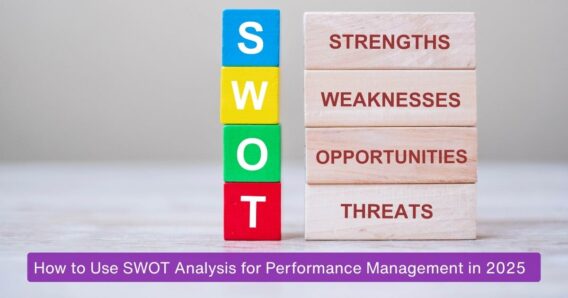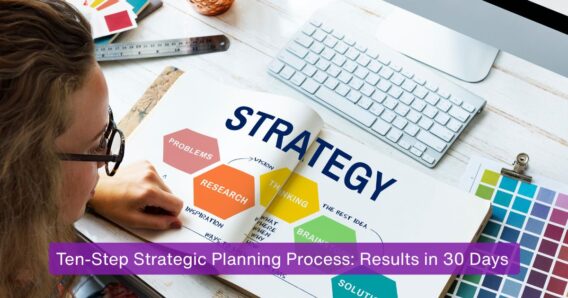Ten-Step Strategic Planning Process: Results in 30 Days.
5 min read
Progress on your strategy doesn’t have to take an entire year or burn folks out in the process. This practical guide outlines a ten-step strategic planning process that can be achieved in 30 days, starting from mission and vision formulation to data-driven learning and rebalancing. You will make defining trade-offs, sharpen your portfolio, and establish a continuous operating cadence that converts plans to shipped results. Conceptually, keep things simple and the actions tangible: select a market, determine the winning strategy, fund the Work Breakdown Structure incrementally, set a limit to the amount of WIP, and perform outcome reviews every 30 days. If you want things like templates and coaching on where to start, our strategic management courses help you quickly establish those habits in the teams and functions that need them the most.
The Framework: 10 Steps That Deliver Results
1. Mission & Vision: why we exist and where we’re going
Now, you must describe your mission (purpose) and vision (desired future) in a single sentence. Try reciting both and assess whether you are making the same critical judgments as the person who created them. If you are making the same judgments, then tighten.
2. Situational Diagnosis: customers, competitors, capabilities
Map your customers and their jobs-to-be-done, the rivals and substitutes they could choose, and the few internal capabilities that truly drive advantage. List five uncertainties and the assumptions you must validate first.
3. Where to Play: segments, geographies, channels — plus “won’t-dos.”
Identify the segments you intend to target within this year and the segments you plan to forgo. Include geographic areas as well as channels of distribution. Clearly stated “won’t do” decisions eliminate resource drift and provide focus when requests become urgent.
4. How to Win: value proposition and unfair advantage
Identify your disadvantage, such as distribution, speed, low cost, data, brand, or IP, and the range of compromises you are willing to make to uphold it. Strategy will become challenging to execute if the edge is not clear.
5. Outcome Goals: three to five results that matter
Avoid activity metrics. Choose outcomes like revenue or margin uplift, adoption, cycle time, or NPS. Set baselines and quarterly targets and write a one-line “definition of done” for each.
6. Portfolio Selection: 70/20/10 mix of core, adjacent, and bets
List outcomes-focused initiatives. Use a simple portfolio rule: 70% core (run and improve), 20% adjacent (near-term growth), 10% bets (experiments). Park or kill low-impact ideas now so your list remains short.
7. Resource Allocation: people, budget, time—with WIP limits
Best people and real budgets: focus on a few high-value initiatives. WIP limits: no team runs more than three active projects. It reduces context switching, surfaces trade-offs sooner, and accelerates delivery.
8. Stage-Gate Funding: milestones, evidence, and kill criteria
Tranches of money released with learning milestones: problem validated→ early traction→ unit economics→ scale. Define kill criteria, e.g. activation, CAC/LTV, within time SLAs to enable stopping politely when evidence supports the decision.
9. Operating Cadence: quarterly plans with monthly outcome reviews
Spend 60 minutes every three weeks to analyse outcomes, risk, capacity, and next steps. Talent and budget shifts: Retire the zombies, invest in the winners. Please keep it simple and visible to all owners.
10. Learn & Rebalance: metrics, assumptions, and reallocation.
Track a short list: outcome movement, cycle time, experiment throughput, and budget mix (core/adjacent/bets). Update assumptions, refresh scenarios, and publish changes so everyone understands the “why” behind reallocation.
Make It Real in 30 Days
Week 1: Publish the one-page report on the strategy and the “won’t-do” list.
Week 2: Take stock of all initiatives in the pipeline, assign core/adjacent/bets tags, and set WIP limits.
Week 3: Append stage gates, kill rules, owners and outcome metrics.
Week 4: Conduct your first outcome review and relocate budget and personnel accordingly.
Why training speeds results
Frameworks are simple to comprehend but more challenging to land across functions. That is the reason for strategic management courses: every learner gets one-page strategy templates, portfolio dashboards, stage-gate scorecards, review agendas, and training to manage objections and set real trade-offs. Real-time portfolios are used for practice, and learners leave with a certificate that signifies their capability.
Conclusion
Within the next 30 days, you should be operational with this highly organised system: make target selections, optimise the portfolio with the 70/20/10 rule, WIP, fund incrementally, and self-assess the outcomes monthly. If you want faster lift-off with templates and coaching, enrol in our strategic management courses and turn intent into allocation—and allocation into measurable results. What is the most important lesson you’ve learned from this?




